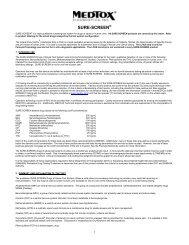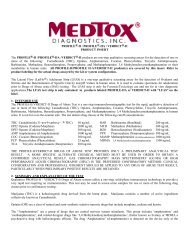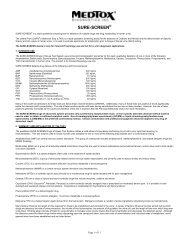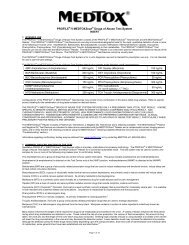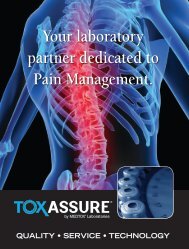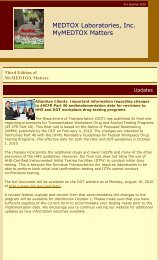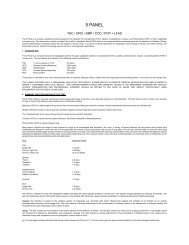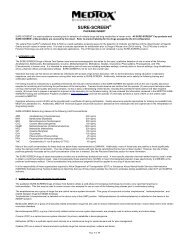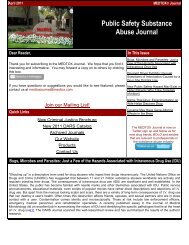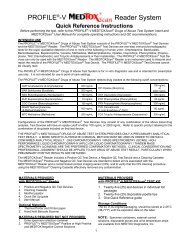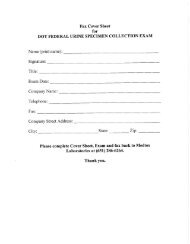Package Insert-II Rev. 8/11 - Medtox
Package Insert-II Rev. 8/11 - Medtox
Package Insert-II Rev. 8/11 - Medtox
You also want an ePaper? Increase the reach of your titles
YUMPU automatically turns print PDFs into web optimized ePapers that Google loves.
EZ-SCREEN ® CUP <strong>Package</strong> <strong>Insert</strong>-<strong>II</strong><br />
The EZ-SCREEN ® Cup products are rapid qualitative screening assays for the detection of any combination of the following drugs or their metabolites in human<br />
urine: Amphetamine, Barbiturates, Benzodiazepines, Cocaine, Methamphetamine, Methadone, Opiates, Oxycodone, Phencyclidine, Propoxyphene, and TH<br />
(Cannabinoids). Configurations of EZ-SCREEN ® Cup products can consist of any combination of the tests listed in this insert. Refer to product labeling<br />
for the drugs assayed by the kit configuration.<br />
The adulterant strip is a rapid qualitative screening assay for the detection of Oxidants, Nitrites, and the determination of Specific Gravity and pH values in human<br />
urine. It is used to evaluate specimens for adulteration and dilution prior to Drugs of Abuse urine (DAU) testing. The adulterant strip is only for forensic/toxicology<br />
use and not for in vitro diagnostic applications.<br />
1. INTENDED USE<br />
The EZ-SCREEN ® Cup Drugs of Abuse Test is a one-step immunochromatographic test for the rapid, qualitative detection of one or more of the following:<br />
Amphetamine, Barbiturates, Benzodiazepines, Cocaine, Methamphetamine, Methadone, Opiates, Oxycodone, Phencyclidine, Propoxyphene, and TH<br />
(Cannabinoids) in human urine. EZ-SCREEN ® Cup is not for over-the-counter sale. The test detects drug classes at the following cutoff concentrations:<br />
Test ID Drug Class (calibrator) Cutoff Test ID Drug Class (calibrator) Cutoff<br />
AM Amphetamine (d-Amphetamine) 1000 ng/mL OP Opiates (Morphine) 2000 ng/mL<br />
BA Barbiturates (Butalbital) 200 ng/mL OX Oxycodone (Oxycodone) 100 ng/mL<br />
BZ Benzodiazepines (Nordiazepam) 300 ng/mL PC Phencyclidine (Phencylidine) 25 ng/mL<br />
CO Cocaine (Benzoylecgonine) 300 ng/mL PP Propoxyphene (Norpropoxyphene) 300 ng/mL<br />
mA Methamphetamine (d-Methamphetamine) 1000 ng/mL TH Cannabinoids (<strong>11</strong>-nor-9-carboxy-Δ 9 -THC) 50 ng/mL<br />
MT Methadone (Methadone) 300 ng/mL<br />
THE EZ-SCREEN ® CUP DRUGS OF ABUSE TEST PROVIDES ONLY A PRELIMINARY ANALYTICAL TEST RESULT. A MORE SPECIFIC ALTERNATE<br />
CHEMICAL METHOD MUST BE USED IN ORDER TO OBTAIN A CONFIRMED ANALYTICAL RESULT. GAS CHROMATOGRAPHY / MASS SPECTROMETRY<br />
(GC/MS), HIGH PERFORMANCE LIQUID CHROMATOGRAPHY (HPLC) OR LIQUID CHROMATOGRAPHY / TANDEM MASS SPECTROMETRY (LC/MS/MS)<br />
ARE THE PREFERRED CONFIRMATORY METHODS. CLINICAL CONSIDERATION AND PROFESSIONAL JUDGMENT SHOULD BE APPLIED TO ANY DRUG<br />
OF ABUSE TEST RESULT, PARTICULARLY WHEN PRESUMPTIVE POSITIVE RESULTS ARE OBTAINED.<br />
2. SUMMARY AND EXPLANATION OF THE TEST<br />
Qualitative EZ-SCREEN ® Cup Drugs of Abuse Test screens utilize a one-step, solid-phase immunoassay technology to provide a very rapid test requiring no<br />
instrumentation. This test may be used to screen urine samples for one or more of the following drug classes prior to confirmatory testing:<br />
The “Amphetamines” are a group of drugs that are central nervous system stimulants. This group includes „amphetamine‟ and „methamphetamine‟, and related<br />
designer drugs like „3,4 Methylenedioxymethamphetamine‟, (better known as Ecstasy or MDMA, a psychoactive drug with hallucinogenic effects).<br />
The drug „Amphetamine‟ (d-amphetamine) is detected on the device only at the (AM) position. Both the designer drug Ecstasy (mA)<br />
„Methylenedioxymethamphetamine‟ and methamphetamine (d-methamphetamine) are detected on the device at the (mA) position. The (mA) antibody does not<br />
differentiate between methamphetamine and ecstasy.<br />
Barbiturates (BA) are a group of structurally related prescription drugs that are used to reduce restlessness and emotional tension, induce sleep and to treat certain<br />
convulsive disorders.<br />
Benzodiazepines (BZ), a group of structurally related central nervous system depressants, are primarily used to reduce anxiety and induce sleep.<br />
Cocaine (CO) is a central nervous system stimulant. Its primary metabolite is benzoylecgonine.<br />
Methadone (MT) is a synthetic opioid used clinically as a maintenance drug for opiate abusers and for pain management.<br />
Opiates (OP) are a class of natural and semi-synthetic sedative narcotic drugs that include morphine, codeine and heroin.<br />
Oxycodone (OX) (Oxycontin ® , Percodan, Percocet)) is a semi synthetic narcotic analgesic that is prescribed for moderately severe pain. It is available in both<br />
standard and sustained release oral formulations. Oxycodone is metabolized to Oxymorphone and Noroxycodone.<br />
Phencyclidine (PC) is a hallucinogenic drug.<br />
Propoxyphene (PP) is a narcotic analgesic. Its primary metabolite is norpropoxyphene.<br />
Marijuana (TH) is a hallucinogenic drug derived from the hemp plant. Marijuana contains a number of active ingredients collectively known as Cannabinoids.<br />
Many factors influence the length of time required for drugs to be metabolized and excreted in the urine. A variety of factors influence the time period during which<br />
drug metabolites are detected in urine; the rate of urine production, the volume of fluid consumption, the amount of drug taken, the urine pH, and the length of time<br />
over which drug was consumed. Drinking large volumes of liquid or using diuretics to increase urine volume will lower the drug concentration in the urine and may<br />
decrease the detection period. Although the detection period for these drugs varies widely depending upon the compound taken, dose and route of administration<br />
and individual rates of metabolism, some general times have been established and are listed below. 1-5<br />
Page 1 of 13
Drug<br />
Amphetamine<br />
Acid Conditions<br />
Alkaline Condition<br />
Barbiturates<br />
Short-Acting<br />
Long-Acting<br />
Benzodiazepines<br />
Cocaine metabolite<br />
Methadone<br />
Methamphetamine<br />
Acid Conditions<br />
Alkaline Conditions<br />
Detection Period<br />
1-3 days<br />
3-10 days<br />
Up to 6 days<br />
Up to 16 days<br />
1-12 days<br />
Up to 5 days<br />
1 to 3 days typical<br />
1-3 days<br />
1-3 days<br />
3-10 days<br />
Drug<br />
Opiates<br />
Heroin<br />
Morphine<br />
Codeine<br />
Oxycodone<br />
Phencyclidine<br />
Single Use<br />
Chronic Use<br />
Propoxyphene<br />
TH (Cannabinoids)<br />
Single Use<br />
Chronic Use<br />
Detection Period<br />
1 day<br />
1-3 days<br />
1-3 days<br />
1-3 days<br />
1-8 days<br />
Up to 4 weeks<br />
Up to 1 week<br />
1-7 days<br />
Less than 30 days typical<br />
The adulterant strip has impregnated reagent test pads that detect specific analytes in human urine. The analytes detected are Oxidants and Nitrites.<br />
The strip also approximates the pH and specific gravity values. Urine samples with „abnormal‟ values should be submitted to a reference laboratory for<br />
additional testing.<br />
Oxidants The detection is based on the oxidative activity of compounds (e.g. chromate salts and/or Bleach) that catalyze the oxidation of an indicator<br />
by an organic hydroperoxide producing a blue/orange color. The color intensity is directly proportional to the concentration of Oxidants present in the<br />
sample and is observed visually and compared to the color comparator chart to obtain a result.<br />
Nitrites The test is based on the principles of the Griess reaction for the detection of Nitrites. The test pad contains an amine and a coupling<br />
component. A red/orange colored azo compound is obtained by diazotization and subsequent coupling. The color intensity is directly proportional to<br />
the concentration of Nitrites present in the sample and is observed visually and compared to the color comparator chart to obtain a result.<br />
pH The test pad contains indicators that change colors between pH 2 and pH <strong>11</strong>. The color scale gives an approximate indication for pH values<br />
between those levels.<br />
Specific Gravity The test pad reacts with ions in urine to indicate concentrations from 1.000 to 1.020. The color changes range from dark green with<br />
low ionic concentrations through green to yellow/orange in urines with high ionic concentrations. The color is observed visually and compared to the<br />
color comparator chart to obtain an approximate result.<br />
3. PRINCIPLES OF THE PROCEDURE<br />
The EZ-SCREEN ® Cup Drugs of Abuse Test is a rapid, competitive, membrane-based immunochromatographic assay. A single urine sample can be<br />
evaluated for the presence of each of the specified classes of drugs in a single device. The device consists of a control line, drug-conjugates and<br />
antibody-colloidal gold.<br />
1. CONTROL LINE -- Each test strip has anti-mouse immunoglobulin antibody immobilized as a line on the membrane at the Control (C) location on<br />
the device window. The anti-mouse immunoglobulin antibody can bind to any of the mouse antibodies coated on the colloidal gold.<br />
2. DRUG-CONJUGATES -- Drug from the class tested was individually conjugated to a protein that binds to the membrane. Each drug conjugate was<br />
immobilized as a line at a labeled location on the membrane strip.<br />
3. ANTIBODY-COLLOIDAL GOLD -- Each test uses a monoclonal antibody developed to bind to its drug class. Antibody-colloidal gold solutions<br />
were prepared by absorbing each of the individual monoclonal antibodies to colloidal gold. The colloidal gold solutions were applied to the sample pad<br />
in the drugs of abuse test.<br />
The device can be used to detect specific classes of drugs in urine because drug(s) in the urine and the drug(s) conjugated to the protein compete to<br />
bind to the antibody-colloidal gold in a highly specific reaction. When the urine flows into the sample pads of the device, the dried antibody-colloidal<br />
gold on the sample pad(s) dissolves and the urine wicks up the white strips carrying the reddish-purple antibody-colloidal gold as a solution with it.<br />
For specifics on crossreactivity in a drug class see the Related and Reactive Compounds section for that test.<br />
Control Line<br />
Each test strip has an internal procedural control. A line must form at the Control “C” location on the device to indicate that the proper sample volume<br />
was used and that the reagents are migrating properly. If a Control line does not form, the test is considered invalid. A Control line forms when the<br />
antibody-colloidal gold binds to the anti-mouse immunoglobulin antibody immobilized on the membrane at the “C” location on the device.<br />
Negative Samples<br />
When no drug(s) is present in the urine sample, the reddish purple antibody-colloidal gold solutions migrate along the strip then binds to the<br />
appropriate drug conjugate immobilized on the membrane. The binding of the antibody-colloidal gold to the drug conjugate generates an easily visible<br />
reddish-purple line at the appropriate test location on the device. Negative results can be reported as soon as a test line and control line are visible.<br />
Presumptive Positive Samples<br />
When drug(s) is present in the urine sample the antibody-colloidal gold binds to the drug(s) before it migrates along the strip. However, when the<br />
antibody-colloidal gold binds to the drug(s) in the urine, the antibody colloidal gold cannot bind to the drug conjugate immobilized on the membrane.<br />
When the drug concentration is at or above the cutoff concentration, the majority of the antibody-colloidal gold is bound to the drug from the urine.<br />
Therefore, as the drug bound antibody-colloidal gold migrates along the strip(s), it is unable to bind to the appropriate drug conjugate immobilized on<br />
the membrane. Therefore no line is generated at the drug-specific location on the device for a positive sample. Read non-negative results at 5<br />
minutes. The control line should be present for the test to be valid. The test result for Oxycodone (OX) after 5 minutes may not be consistent with the<br />
original reading. For all other tests, read results at 5 minutes or within 15 minutes of the sample application. The test result after 15 minutes may not<br />
be consistent with the original reading.<br />
Page 2 of 13
4. MATERIALS PROVIDED/STORAGE CONDITIONS<br />
Each EZ-SCREEN ® Cup Drugs of Abuse Test contains all the reagents necessary to test one urine sample simultaneously for multiple drugs. Test<br />
devices are available in Cup format as described below.<br />
Kit Contents – Cup Test format<br />
Each Cup Test Kit contains twenty-five (25) test system foil pouches, and one reference guide. Products with adulterant strips contain five (5) Color<br />
Comparator Charts.<br />
Each Cup Test system foil pouch contains:<br />
1. One (1) test cup with temperature strip attached, and test cassette(s) inside.<br />
1. Each test cassette has test strips with drug specific reagents.<br />
2. The test cup may contain a membrane strip laminated with adulterant pads for testing the presence of Oxidants and Nitrites, as<br />
well as determining approximate values of Specific Gravity and pH in human urine. (Products with adulterant strips only; the<br />
adulterant strip is not contained in every EZ-SCREEN ® Cup product.)<br />
2. One (1) lid.<br />
Materials Required but not provided<br />
External controls<br />
Timer<br />
Specimen containers, external controls, disposable gloves and urine temperature strips are available from MEDTOX Diagnostics, Inc.<br />
Storage Conditions<br />
The kit, in its original packaging, should be stored at 2-25°C (36-77°F) until the expiration date on the label.<br />
5. PRECAUTIONS<br />
1. Urine specimens and all materials coming in contact with them should be handled and disposed of as if infectious and capable of transmitting<br />
infection. Avoid contact with broken skin.<br />
2. Avoid cross-contamination of urine samples by using a new urine specimen container for each urine sample.<br />
3. The device should remain in its original sealed foil pouch until ready to use. If the pouch is damaged, do not use the test.<br />
4. Do not store the test kit at temperatures above 25°C (77°F).<br />
5. If devices have been stored refrigerated, bring to ambient temperature (18-25°C/ 64-77°F) prior to opening foil pouch.<br />
6. Do not use tests after the expiration date printed on the package label.<br />
7. The drug screen portion of the device is for in vitro diagnostic use only. The adulterant strip is for forensic/toxicology use only.<br />
6. SAMPLE COLLECTION AND PREPARATION<br />
Collect the urine sample in the EZ-SCREEN ® Cup. The urine volume should be at or above the minimum volume fill line.<br />
This volume of urine is more than sufficient for testing. No preservatives should be added. Tests will begin developing immediately following collection<br />
of urine. If sample needs to be confirmed it can be shipped directly to the confirmation lab in the EZ-SCREEN ® Cup.<br />
7. TEST PROCEDURE<br />
Cup Test<br />
1. Bring pouched cup device to room temperature before opening it.<br />
2. Open pouch and label the device with the patient or sample identification.<br />
3. Remove desiccant from cup.<br />
4. Fill urine sample cup to at least the Fill Line.<br />
5. Tighten lid onto the cup.<br />
6. Keep cup in upright position and minimize handling before reading.<br />
7. If adulterant strip is present, read pH, Specific Gravity, and Nitrites in vertical position as soon as color changes. Read oxidant at 60<br />
seconds.<br />
8. Allow the test cup to sit for 5 minutes after voiding into the cup.<br />
9. Remove the privacy tab and read the results. Control line (C) must be present to read results.<br />
10. If remove privacy tab before 5 minutes, negative results can be read as soon as a test line and control line (C) is visible and presumptive<br />
positive at 5 minutes after voiding into the cup.<br />
NOTE: Read results at 5 minutes or within 15 minutes of voiding into the cup. Oxycodone should be read at 5 minutes. Test results interpreted<br />
after 15 minutes (for Oxycodone after 5 minutes) may not be consistent with the original results obtained at 5 minutes.<br />
8. READING THE TEST RESULTS<br />
Invalid:<br />
Negative:<br />
The absence of a reddish-purple Control (C) line at 5 minutes indicates the test is invalid. The urine sample should be retested on a<br />
new device. If the second test is also invalid, send the urine sample to a reference laboratory for additional testing.<br />
The appearance of both a reddish-purple Control (C) line and a specific drug line (AM, BA, BZ, CO, mA, MT, OP, OX, PC, PP or TH)<br />
indicates a negative test result. The color intensities of the Control line (C) and a specific drug line may not be equal; any reddishpurple<br />
line visible at 5 minutes indicates a negative test result for that drug. Line intensity will vary from test to test.<br />
Presumptive Positive:<br />
The appearance of both a reddish-purple Control (C) line and the absence of a line next to a specific drug name (AM, BA,<br />
BZ, CO, mA, MT, OP, OX, PC, PP or TH) at 5 minutes indicates a presumptive positive test result for that drug.<br />
Occasionally a white line (line lighter than the background of the strip) may appear next to a specific drug name. This<br />
indicates a presumptive positive test result for that drug.<br />
Page 3 of 13
Examples of Negative, Presumptive Positive and Invalid results:<br />
INVALID<br />
(C line is missing)<br />
NEGATIVE<br />
PRESUMPTIVE<br />
POSITIVE<br />
(OP Test)<br />
There are other possible results depending on the drug or combination of drugs present in the urine sample.<br />
9. INTERPRETATION OF TEST RESULTS<br />
A NEGATIVE test result for a specific drug indicates that the sample does not contain the drug/drug metabolite above the cutoff level.<br />
A PRESUMPTIVE POSITIVE test result for a specific drug indicates that the sample may contain drug/drug metabolite near or above the cutoff level. It<br />
does not indicate the level of intoxication or the specific concentration of drug in the urine sample. Presumptive Positive samples or those with<br />
abnormal adulterant strip results should be sent to a reference laboratory for more definitive testing.<br />
10. QUALITY CONTROL<br />
An internal procedural control is included on each test strip. A line must form at the Control (C) position in the result window to indicate that the proper<br />
sample volume was used and that the reagents are migrating properly. If a Control line does not form, the test is considered invalid. The Control line<br />
consists of immobilized anti-mouse antibody that reacts with the antibody-colloidal gold as it passes this region of the membrane. Formation of a<br />
visible line verifies the Control line antibody antigen reaction occurred. This line may be considered an internal negative procedural control. In<br />
addition, if the test has been performed correctly and the device is working properly, the background will clear such that result lines are distinct. The<br />
cleared background may be considered an internal positive procedural control. The visible Control line (C) should always be present regardless of<br />
whether drug is absent or present in the sample.<br />
The purpose of quality control in laboratory testing is to ensure accuracy, reliability of results and to detect errors. Because the devices are selfcontained,<br />
single use tests, traditional quality control programs do not apply. The Quality Control program MEDTOX recommends for these noninstrumented<br />
test devices includes a combination of the internal device controls and external controls to ensure accuracy, reliability and to detect<br />
possible errors. The on-board reactive device controls may be one aspect of the quality program utilized by a laboratory to satisfy the daily quality<br />
control requirement established by the Laboratory Director. Another aspect of a quality control program includes an external negative control<br />
containing no drug and a positive drug control challenging to the assay cutoff concentration. These controls may be used to initially test each shipment<br />
of product received by the laboratory or to verify appropriate storage conditions and long-term stability of the test reagent. To follow good laboratory<br />
practices, we recommend that the user document the receipt of each new lot number of devices, the results of external controls performed initially and<br />
periodically thereafter, and the results of the internal controls within each device.<br />
It is the responsibility of each Laboratory Director to demonstrate and document the validity of the alternate QC procedure they choose to use in their<br />
laboratory. For additional information or forensic and workplace testing requirements, users should contact and follow the appropriate federal, state,<br />
and local guidelines. Quality control materials are available from MEDTOX and commercial sources. Contact MEDTOX for further information.<br />
<strong>11</strong>. LIMITATIONS OF THE PROCEDURE<br />
1. The EZ-SCREEN ® Cup Drugs of Abuse Test is only for use with unadulterated human urine samples collected in the EZ-SCREEN ® Cup. Urine<br />
samples which are either extremely acidic (below pH 4.0) or basic (above pH 9.0) may produce erroneous results.<br />
2. Urine samples which are collected in another cup and then poured into an EZ-SCREEN ® Cup may produce erroneous results.<br />
3. Keep the EZ-SCREEN ® Cup upright while strips are developing. Turning the EZ-SCREEN ® Cup upside down or on its side may produce<br />
erroneous or invalid results.<br />
4. Shaking or excessive agitation of the EZ-SCREEN ® Cup may produce erroneous or invalid results.<br />
5. A positive result for any drug(s) does not indicate or measure intoxication. It only indicates the presence of reacting compound(s) in the urine<br />
specimen.<br />
6. Test results interpreted after 15 minutes (5 minutes with OX) may not be consistent with the original result obtained at 5 minutes.<br />
7. The Drugs of Abuse Test was not evaluated in point-of-care settings.<br />
8. There is a possibility that other substances and/or factors, e.g. technical or procedural errors, may interfere with the test and cause false results.<br />
Adulterant Strip limitations<br />
The purpose of the adulterant strip is to screen for abnormal conditions in human urine samples, such as dilution or the addition of drug-test interfering<br />
substances. Occasionally medications may discolor the urine, and make it difficult to read the result. When in doubt send the urine sample to a<br />
reference laboratory for additional testing.<br />
Oxidant<br />
Nitrites, acting as oxidizing agents in solution, will produce a blue/green color change on the Oxidant pad.<br />
Nitrite<br />
Abnormal results can be caused by the presence of diagnostic or therapeutic dyes in the urine. Very high concentrations of oxidant such as 80%<br />
bleach will produce a brown color change on the Nitrite pad.<br />
Page 4 of 13
12. EXPECTED VALUES<br />
The Substance Abuse and Mental Health Services Administration (SAMHSA) recommends the following screening test cutoffs:<br />
AM Amphetamine 1000 ng/mL<br />
CO Benzoylecgonine 300 ng/mL<br />
mA Methamphetamine 1000 ng/mL<br />
OP Morphine 2000 ng/mL<br />
PC Phencyclidine 25 ng/mL<br />
TH <strong>11</strong>-nor-9-carboxy-∆ 9 -THC 50 ng/mL<br />
There are no SAMHSA recommended screening levels for barbiturates, benzodiazepines, MDMA, methadone, oxycodone and propoxyphene and/or<br />
their metabolites.<br />
The Drugs of Abuse Test qualitatively detects amphetamine, barbiturates, benzodiazepines, cocaine, methadone, methamphetamine, opiates,<br />
oxycodone, phencyclidine, propoxyphene, and cannabinoids and/or their metabolites in human urine at or above their specified cutoff level (See<br />
Specificity).<br />
Adulterant Strip<br />
Urines that produce an abnormal result on the adulterant strip should be sent to a reference laboratory for more definitive testing to determine if the<br />
urine may be dilute, substituted, invalid and/or adulterated.<br />
13. PERFORMANCE CHARACTERISTICS<br />
Sensitivity<br />
The Drugs of Abuse Test detects one or more of the following drugs at cutoff levels listed below. Cutoffs for amphetamines, cocaine metabolite,<br />
methamphetamines, opiates, phencyclidine, and cannabinoids (THC) are based on SAMHSA recommendations for screening of these drugs in human<br />
urine. There are no SAMHSA recommended screening cutoff levels for barbiturates, benzodiazepines, methadone, oxycodone, norpropoxyphene, or<br />
propoxyphene.<br />
AM Amphetamine 1000 ng/mL<br />
BA Barbiturates (Butalbital) 200 ng/mL<br />
BZ Benzodiazepines (Nordiazepine) 300 ng/mL<br />
CO Benzoylecgonine 300 ng/mL<br />
mA Methamphetamine 1000 ng/mL<br />
MT Methadone 300 ng/mL<br />
OP Morphine 2000 ng/mL<br />
OX Oxycodone 100 ng/mL<br />
PC Phencyclidine 25 ng/mL<br />
PP Propoxyphene (Norpropoxyphene) 300 ng/mL<br />
TH <strong>11</strong>-nor-9-carboxy-∆ 9 -THC 50 ng/mL<br />
Accuracy<br />
A panel of naturally metabolized urine samples for the following drug(s) was analyzed using the MEDTOX ® AM, CO, OP, PC and TH Tests and the<br />
Boehringer Mannheim qualitative CEDIA ® assay or the ROCHE ABUSCREEN ONLINE ® for each drug and the results were compared. Results are<br />
shown in the following tables.<br />
ACCURACY COMPARED TO THE BOEHRINGER MANNHEIM QUALITATIVE CEDIA ®<br />
or THE ROCHE ABUSCREEN ONLINE ® <strong>II</strong> ASSAYS<br />
CEDIA AMPHETAMINE (1000 ng/mL cutoff)<br />
Positive Negative TOTAL<br />
AM (1000 ng/mL cutoff) Positive 64 0 64<br />
Negative 2 618 620<br />
TOTAL 66 618 684<br />
Overall agreement: >99% (682/684). Samples having discrepant results were analyzed by GC/MS. The two false negative samples contained<br />
amphetamine at 2353 and 3569 ng/mL.<br />
CEDIA COCAINE (300 ng/mL cutoff)<br />
Positive Negative TOTAL<br />
CO (300 ng/mL cutoff) Positive 96 8 104<br />
Negative 2 578 580<br />
TOTAL 98 586 684<br />
Overall agreement: 99% (674/684). Samples having discrepant results were analyzed by GC/MS. Of the eight false positive samples one contained<br />
151 ng/mL while seven did not contain cocaine metabolite detectable at the GC/MS cutoff of 150 ng/mL. The two false negative samples contained<br />
cocaine metabolite at 688 and 666 ng/mL.<br />
ROCHE ABUSCREEN ONLINE ® -<strong>II</strong> OPIATE (2000 ng/mL cutoff)<br />
Positive Negative TOTAL<br />
OP (2000 ng/mL cutoff) Positive 68 0 68<br />
Negative 0 89 89<br />
TOTAL 68 89 157<br />
Overall agreement: 100% (157/157).<br />
Page 5 of 13
CEDIA PHENCYCLIDINE (25 ng/mL cutoff)<br />
Positive Negative TOTAL<br />
PC (25 ng/mL cutoff) Positive 56 2 58<br />
Negative 1 625 626<br />
TOTAL 57 627 684<br />
Overall agreement: >99% (681/684). Samples having discrepant results were analyzed by GC/MS. The two false positive samples did not contain<br />
phencyclidine detectable at the GC/MS cutoff of 25ng/mL. The one false negative sample contained phencyclidine at 28 ng/mL.<br />
CEDIA MULTI-LEVEL THC (50 ng/mL cutoff)<br />
Positive Negative TOTAL<br />
TH (50 ng/mL cutoff) Positive 194 3 197<br />
Negative 10 477 487<br />
TOTAL 204 480 684<br />
Overall agreement: 98% (671/684). Samples having discrepant results were analyzed by GC/MS. The three false positive samples were found to<br />
contain 16, 28, and 32 ng/mL while the ten false negative samples contained 32, 35, 41, 42, 46, 46, 49, 50, 50, and 90 ng/mL.<br />
RELATIVE SENSITIVITY AND SPECIFICITY COMPARED TO THE BOEHRINGER MANNHEIM<br />
QUALITATIVE CEDIA ® or THE ROCHE ABUSCREEN ONLINE ® <strong>II</strong> ASSAYS<br />
(Amphetamines, Cocaine, Opiates, PCP and THC)<br />
Relative Sensitivity<br />
Relative Specificity<br />
AM 97% (64/66) 100% (618/618)<br />
CO 98% (96/98) 99% (578/586)<br />
OP 100% (68/68) 100% (89/89)<br />
PC 98% (56/57) >99% (625/627)<br />
TH 95% (94/204) 99% (477/480)<br />
ACCURACY COMPARED to GC/MS<br />
Values for discrepant<br />
MEDTOX ® Tests GC/MS Samples (ng/mL)<br />
AM Positive 48 50<br />
Negative 52 50 2353 and 3569<br />
CO Positive 49 50<br />
Negative 51 50 666<br />
OP Positive 47 47<br />
Negative 0 0 No Discrepants<br />
PC Positive 49 50<br />
Negative 51 50 28<br />
TH Positive 48 50<br />
Negative 52 50 35 and 46<br />
Precision (Amphetamines, Cocaine, Opiates, Phencyclidine, and Cannabinoids)<br />
Performance around the specific cutoff for each drug was measured by testing standard drug solutions diluted in drug-free urine in replicates of 20<br />
each on 3 different days by 3 operators. Twenty replicates of drug-free urine were also tested on each day. At 25% above the cutoff, the precision of<br />
each assay was as follows: AM=100%, CO=100%, OP=96.7%, PC=100% and TH=95%.<br />
Reproducibility (Amphetamines, Cocaine, Phencyclidine, and Cannabinoids)<br />
A panel of 55 naturally metabolized human urine samples was prepared. All samples in the panel had been screened for the presence or absence of<br />
amphetamines, cocaine, phencyclidine, and cannabinoids. In addition, each of the 55 samples had also been quantitated by GC/MS conducted at<br />
SAMHSA cutoffs for positive samples or at limit of quantitation for negative samples to determine the concentration of a specific drug. Five of the 55<br />
samples were drug-free negatives and 50 of the samples were positive for one or more of the four drugs above. The concentration of primary<br />
metabolite in the positive samples was between 1056 and 4622 ng/mL for AM; 487 and 1342 ng/mL for CO; 32 and 109 ng/mL for PC and 66 and 198<br />
ng/mL for TH. The panel was used to evaluate the lot-to-lot and lab-to-lab reproducibility.<br />
Lot-to-Lot Reproducibility (Amphetamines, Cocaine, Phencyclidine, and Cannabinoids)<br />
Three aliquots of each of the 55 samples were prepared and each of the three sets of aliquots was coded and used to evaluate the performance of one<br />
of three lots of drug tests for the four drugs above. There was one incorrect result (a false negative on an amphetamine low positive sample) on the<br />
825 tests for a reproducibility of >99%.<br />
Lab-to-Lab Reproducibility (Amphetamines, Cocaine, Phencyclidine, and Cannabinoids)<br />
Three aliquots of each of the 55 samples were prepared and each of the three sets of aliquots was tested by one of three study participants using one<br />
lot of drug test for the four drugs above. There was >99% agreement between the three participants. Overall, there was one incorrect result (for PC,<br />
one false negative on a low positive sample) on the 825 tests.<br />
Reproducibility (Opiates 2000)<br />
A panel of 25 naturally metabolized human urine samples was prepared. All samples in the panel had been screened for the presence or absence of<br />
opiates. In addition, each of the positive samples had also been quantitated by GC/MS conducted at SAMHSA cutoff for positive samples to determine<br />
the concentration of morphine and codeine. The concentration of morphine and/or codeine in the positive samples was between 2000 and 6000<br />
ng/mL. The panel was used to evaluate Opiates 2000 for lot-to-lot and lab-to-lab reproducibility. There were no incorrect results on the 75 tests (25<br />
samples x 3 lots) for a lot-to-lot reproducibility of 100%. There were no incorrect results on the 75 tests (25 samples x 3 study participants) for a lab-tolab<br />
reproducibility of 100%.<br />
Page 6 of 13
Accuracy (Propoxyphene)<br />
One-hundred forty one (141) clinical samples were evaluated by the Roche Abuscreen OnLine Propoxyphene assay, using a 300 ng/mL cut off. Sixty<br />
(60) samples were found to be negative and eighty-one (81) samples were found to be positive by the Roche method. Three aliquots of each sample<br />
were prepared, and assayed by three operators in a masked manner. There was no significant difference in the results obtained by the three<br />
operators, therefore the results of all three operators are included in the table. Results of this comparison are as follows:<br />
OnLine Positive<br />
OnLine Negative<br />
238 0<br />
PP (300 ng/mL cutoff) 5* 180<br />
* GC/MS results are 390, 441, 499, 536 and 679 ng/mL<br />
In addition to the 141 clinical samples, eight additional clinical samples containing only norpropoxyphene were diluted with drug-free urine in order to<br />
obtain an adequate number of samples that had concentrations of drug that were challenging to the cutoff. These eight diluted samples, and the 141<br />
clinical samples described above were analyzed by GC/MS for propoxyphene and norpropoxyphene. The level of quantitation of the GC/MS was 30<br />
ng/mL. Only ten of the samples contained propoxyphene, and each of these samples had norpropoxyphene levels greater than 1,647 ng/mL. As in<br />
the study above, three aliquots of the 149 samples were prepared, coded, and assayed by three operators in a masked manner. There was no<br />
significant difference in the results obtained by the three operators, therefore the results of all three operators are included in the comparison table.<br />
GC/MS Range (ng/mL) None detected 150-265 339-450 >472<br />
Number of samples 60 8 (Diluted samples) 7 74<br />
Positive 0 12 19 219<br />
Negative 180 12 2 3<br />
Sensitivity/Precision/Distribution of Random Error (Propoxyphene)<br />
Performance around the specific cut-off of 300 ng/mL for norpropoxyphene was evaluated by testing standard drug solutions diluted in drug-free urine<br />
in triplicate on 5 different days by 3 operators. Drug-free urine was also tested on each day. There was no significant difference in the results of the<br />
three operators so the results were combined and are shown in the following table.<br />
Norpropoxyphene Cut-off = 300 ng/mL<br />
Conc. (ng/mL) Number Tested Positive Negative % Agreement<br />
0 45 0 45 100<br />
30 45 0 45 100<br />
75 45 1 44 98<br />
150 45 9 36 80<br />
225 45 16 29 64<br />
300 45 37 8 82<br />
375 45 42 3 93<br />
450 45 44 1 98<br />
600 45 45 0 100<br />
Accuracy (Methamphetamine)<br />
A panel of naturally metabolized urine samples was analyzed using the MEDTOX ® mA Test and the GC/MS assay for methamphetamine. The results<br />
obtained in the procedures are shown in the following tables.<br />
GC/MS Methamphetamine (limit of quantitation 50 ng/mL)<br />
Positive Negative TOTAL<br />
mA-Methamphetamine Positive 56 0 56<br />
(1000 ng/mL cut-off) Negative 2 56 58<br />
TOTAL 58 56 <strong>11</strong>4<br />
Overall agreement: >98% (<strong>11</strong>2/<strong>11</strong>4). Samples having discrepant results were analyzed by GC/MS. The false negative samples contained<br />
methamphetamine at 1056 ng/mL and at <strong>11</strong>36 ng/mL.<br />
Percent Agreement of mA Compared to GC/MS<br />
POSITIVE<br />
NEGATIVE<br />
mA-Methamphetamine 97% (56/58) 100% (56/56)<br />
Sensitivity/Precision (Methamphetamine)<br />
Performance for the MEDTOX ® mA Test for methamphetamine was evaluated by testing standard drug solutions diluted in drug-free urine in duplicates<br />
of 8 drug concentrations on 5 different days by 3 operators. Drug-free urine was also tested on each day. The complete results for both drugs are<br />
shown in the tables below.<br />
Methamphetamine Cut-off = 1000 ng/mL<br />
Conc. (ng/mL) No. Tested (+) (-) % Agreement<br />
0 30 0 30 100<br />
100 30 0 30 100<br />
250 30 0 30 100<br />
500 30 26 4 87<br />
750 30 27 3 90<br />
1000 30 28 2 93<br />
1250 30 29 1 97<br />
1500 30 30 0 100<br />
2000 30 30 0 100<br />
Reproducibility (Methamphetamine)<br />
A panel of 18 spiked human urine samples, comprised of drug-free and drug standard samples, was prepared. The panel was examined by 3<br />
operators, once a day for 5 days. The concentration of methamphetamine had been quantitated by GC/MS in each of the 18 samples. There was<br />
100% agreement between the three operators over the 5 day period at 0 ng/mL, 1500 ng/mL (cut-off + 50%) and 2000 ng/mL (cut-off + 100%) for<br />
methamphetamine.<br />
Page 7 of 13
Accuracy (Barbiturates, Benzodiazepines and Methadone)<br />
The accuracy was evaluated by assaying a coded panel of clinical urine samples containing varying concentrations of drugs and comparing the results<br />
to validated methods. Validated GC/MS assays measured barbiturates, benzodiazepines, and methadone levels. Results are shown in the following<br />
tables.<br />
ACCURACY COMPARED TO GC/MS<br />
(Barbiturates, Benzodiazepines, and Methadone)<br />
DRUG CLASS Concentration Range Number MEDTOX ®<br />
(ng/mL) of Samples Results<br />
Barbiturates<br />
Phenobarbital 201 – 27776 36 36/36 Positive<br />
155, 155, 156, 158, 161 5 5/5 Negative<br />
Butalbital 240 - 3814 27 27/27 Positive<br />
109, 151, 194 3 3/3 Positive<br />
Pentobarbital 264 1 1/1 Positive<br />
Benzodiazepines 303 – 30813 57 57/57 Positive<br />
234, 236, 238, 250, 283 5 5/5 Negative<br />
Methadone 306 - 70560 57 57/57 Positive<br />
224, 226, 227, 230, 232 5 5/5 Negative<br />
Additionally, the accuracy was evaluated in comparison to the Roche Diagnostics Systems, Inc., ABUSCREEN ONLINE ® assays for barbiturates,<br />
benzodiazepines and methadone. A panel of clinical urine samples was analyzed and the results obtained in the procedures were compared. Results<br />
are shown in the following tables.<br />
ACCURACY COMPARED TO THE ROCHE ABUSCREEN ONLINE ® <strong>II</strong><br />
(Barbiturates, Benzodiazepines, and Methadone)<br />
ABUSCREEN ONLINE ® <strong>II</strong> Barbiturates Result (Secobarbital)<br />
(300 ng/mL cutoff)<br />
Positive Negative TOTAL<br />
BA (200 ng/mL cutoff) Positive 62 0 62<br />
Butalbital Test Negative 0 45 46<br />
TOTAL 62 45 107<br />
Overall agreement: 100% (107/107).<br />
ABUSCREEN ONLINE ® <strong>II</strong> Benzodiazepines Result<br />
(300 ng/mL cutoff)<br />
Positive Negative TOTAL<br />
BZ (300 ng/mL cutoff) Positive 57 0 57<br />
Nordiazepam Test Negative 0 45 45<br />
TOTAL 57 45 102<br />
Overall agreement: 100% (102/102).<br />
ABUSCREEN ONLINE ® <strong>II</strong> Methadone Result<br />
(300 ng/mL cutoff)<br />
Positive Negative TOTAL<br />
MT (300 ng/mL cutoff) Positive 55 0 55<br />
Methadone Test Negative 0 45 45<br />
TOTAL 55 45 100<br />
Overall agreement: 100% (100/100).<br />
PERCENT AGREEMENT COMPARED TO ROCHE ABUSCREEN ONLINE ASSAYS<br />
(Barbiturates, Benzodiazepines, and Methadone)<br />
_POSITIVE__<br />
_NEGATIVE_<br />
Barbiturates 100% (62/62) 100% (45/45)<br />
Benzodiazepines 100% (57/57) 100% (45/45)<br />
Methadone 100% (55/55) 100% (45/45)<br />
Sensitivity / Precision / Distribution of Random Error (Barbiturates, Benzodiazepines, and Methadone)<br />
Performance around the specific cutoff for each drug was evaluated by testing standard drug solutions diluted in drug-free urine in triplicate on 5<br />
different days by 3 operators. Drug-free urine was also tested on each day. Operator-to-operator agreement was excellent; therefore, the data were<br />
combined and summarized in the following tables.<br />
Barbiturates (Butalbital) Cutoff = 200 ng/mL<br />
Conc. (ng/mL) Number Tested Positive Negative % Agreement<br />
Negative 45 0 45 100<br />
50 45 0 45 100<br />
100 45 0 45 100<br />
150 45 12 33 73<br />
200 45 43 2 96<br />
250 45 45 0 100<br />
300 45 45 0 100<br />
Page 8 of 13
Benzodiazepines (Nordiazepam) Cutoff = 300 ng/mL<br />
Conc. (ng/mL) Number Tested Positive Negative % Agreement<br />
Negative 45 0 45 100<br />
30 45 0 45 100<br />
75 45 6 39 87<br />
150 45 27 18 60<br />
225 45 41 4 91<br />
300 45 42 3 93<br />
375 45 43 2 96<br />
450 45 45 0 100<br />
600 45 45 0 100<br />
Methadone (Methadone) Cutoff = 300 ng/mL<br />
Conc. (ng/mL) Number Tested Positive Negative % Agreement<br />
Negative 45 0 45 100<br />
30 45 3 42 93<br />
75 45 28 17 62<br />
150 45 35 10 78<br />
225 45 43 2 96<br />
300 45 45 0 100<br />
375 45 45 0 100<br />
450 45 43 2 96<br />
600 45 44 1 98<br />
Accuracy (Oxycodone)<br />
The accuracy was evaluated by assaying a panel of blind coded clinical urine samples containing varying concentrations of drugs and comparing to<br />
GC/MS results. The samples were obtained from MEDTOX Laboratories. Samples that screened negative by the predicate device were not confirmed<br />
by GC/MS. Positive samples were confirmed by GC/MS. The GC/MS determination included Oxycodone and oxymorphone and a weighted<br />
concentration using 100% cross-reactivity for Oxycodone and a 50% cross-reactivity for oxymorphone was calculated. Clinical urine samples<br />
containing Oxycodone and oxymorphone at higher concentrations were diluted with negative urine to obtain the desired number of samples with<br />
concentrations below and above the cutoff. The testing was performed by nine MEDTOX personnel at one site.<br />
MEDTOX ®<br />
OXYCODONE<br />
Results<br />
Negative by<br />
Immunoassay<br />
(Predicate<br />
Device)<br />
MEDTOX ® OXYCODONE Results vs. stratified GC/MS Values<br />
Concentration up<br />
to 50% below the<br />
cutoff<br />
Near Cutoff Negative<br />
(Between 50% below the<br />
cutoff and the cutoff<br />
concentration)<br />
Near Cutoff Positive<br />
(Between the cutoff and<br />
50% above the cutoff<br />
concentration)<br />
High Positive (Greater<br />
than 50% above the<br />
cutoff concentration)<br />
Positive 0 2 2 6 38<br />
Negative 103 5 4 1 0<br />
GC/MS values used to categorize samples in this table are determined by adding together the concentration of Oxycodone plus 50% of the<br />
concentration of oxymorphone, based on the MEDTOX ® OXYCODONE cross-reactivity studies.<br />
% Agreement among positives is 98%. % Agreement among negatives is 97%.<br />
Sensitivity/Precision (Oxycodone)<br />
Performance around the specific cutoff for Oxycodone was evaluated by testing standard drug solutions diluted in drug-free urine in triplicate on 6<br />
different intervals by 3 in-house operators. Drug free urine was also tested on each interval. The results were interpreted at five minutes and are<br />
summarized below:<br />
MEDTOX ® OXYCODONE Precision Study Results<br />
Concentration of sample<br />
(ng/mL)<br />
Number of determinations<br />
Results<br />
#Neg / #Pos<br />
0 54 54 / 0<br />
25 54 54 / 0<br />
50 54 50 / 4<br />
75 54 14 / 40<br />
100 54 4 / 50<br />
125 54 1 / 53<br />
150 54 0 / 54<br />
Non Crossreactive Endogenous Compounds<br />
Listed compounds were dissolved in appropriate solvents and then added to drug-free urine for evaluation with all tests. Most of the compounds were<br />
evaluated for reactivity at 100 µg/mL (albumin was evaluated at 20 mg/mL and bilirubin was evaluated at 200 μg/mL). Samples were evaluated in<br />
triplicate by in-house operators. None of these compounds showed cross-reactivity at the listed concentrations.<br />
Acetaldehyde Creatinine Hemoglobin, Human<br />
Acetone Epinephrine Sodium Chloride<br />
Albumin, Human -Estradiol Tetrahydrocortisone<br />
Bilirubin Estriol d,1-Thyroxine<br />
Cholesterol Glucose Std. Solution Uric Acid<br />
Page 9 of 13
Unrelated Compounds, Prescription and Over-the-Counter Medications<br />
The following compounds were tested for reactivity. Listed compounds were dissolved in appropriate solvents and then added to drug-free urine for<br />
testing. Samples were evaluated in triplicate by in-house operators. Unless otherwise noted by a drug name abbreviation such as “AM” or “BA” etc.,<br />
all of the listed compounds were negative in each of the tests at 100 µg/mL or the highest level tested. If a drug name is followed by an abbreviation<br />
such as “AM” or “BA” etc., check the “Related Compounds and Cross Reactants” listing for the drug in question under the appropriate heading (AM,<br />
BA, etc.) to find its level of cross-reactivity to that test.<br />
Acecainide (N-Acetylprocainamide) Acetaminophen Acetylsalicyclic Acid<br />
Allobarbital-BA Alphenal-BA Alprazolam-BZ<br />
Alprazolam, 1-Hydroxy-BZ p-Aminobenzoic Acid 7-Aminoclonazepam<br />
7-Aminoflunitrazepam Amino glutethimide l-Aminopyrine (4-(dimethylamino) antipyrine)<br />
Amitriptyline Amobarbital-BA Amoxapine<br />
Amoxicillin d-Amphetamine-AM l-Amphetamine-AM<br />
Ampicillin Apomorphine l-Ascorbic Acid<br />
Aspartame Atenolol Atomoxetine<br />
Atropine Sulfate Barbital-BA Barbituric Acid<br />
Benzilic Acid Benzoic Acid Benzocaine (ethyl-4-aminobenzoate)<br />
Benzoylecgonine-CO Benzphetamine Benztropine<br />
Brompheniramine Buprenorphine Bupropion<br />
Butabarbital-BA Butalbital-BA Caffeine<br />
Cannabidiol Cannabinol Captopril<br />
Carbamazepine Carbamazepine- 10,<strong>11</strong> epoxide Carisoprodol (Meprobamate)<br />
Cephalexin Chloral Hydrate Chloramphenicol<br />
Chlordiazepoxide Chloroquine Chlorothiazide<br />
Chlorpheniramine Chlorpromazine Chlorprothixene<br />
Clobazam-BZ Clomipramine Clonazepam-BZ<br />
Clonidine Clorazepate-BZ Clozapine<br />
Cocaine-CO Codeine-OP, OX Cortisone<br />
Cotinine Cyclobenzaprine Cyclopentobarbital-BA<br />
Deoxycorticosterone Desalkylflurazepam-BZ Desipramine<br />
Desmethylchlordiazepoxide-BZ Desmethylflunitrazepam-BZ Desmethylvenlafaxine<br />
Dexamethasone Dextromethorphan Diacetylmorphine-OP<br />
Diazepam-BZ Diclofenac Diethylpropion<br />
Diflunisal Digoxin Dihydrocodeine-OP, OX<br />
Dimenhydrinate (Dramamine) 1,3-Dimethylbarbituric acid Diphenhydramine<br />
Diphenylhydantoin (Phenytoin)-BA Domperidone Dopamine<br />
Doxepin Doxylamine Ecgonine<br />
EDDP-(Primary metabolite of methadone) Efavirenz (Sustiva) EMDP-(Secondary metabolite of methadone)<br />
Ephedrine-mA Equilin Erythromycin<br />
Estrone Ethanol Ethylmorphine-OP, OX<br />
Fenfluramine-mA Fenoprofen Fentanyl (Synthetic opiate)<br />
Flunitrazepam-BZ Fluoxetine (Prozac) Flurazepam<br />
Furosemide Fluvoxamine Gentisic Acid (2,5-Dihydroxybenzoic acid)<br />
Glutethimide Guaiacol Glyceryl Ether Haloperidol<br />
Hexobarbital Hippuric acid Hydralazine<br />
Hydrochlorothiazide Hydrocodone-OP, OX Hydrocortisone<br />
Hydromorphone-OP, OX Hydroxybupropion Hydroxyhippuric Acid<br />
l-<strong>11</strong>-Hydroxy- 9 -THC p-Hydroxyphenobarbital-BA 4-Hydroxyphencyclidine-PC<br />
3-Hydroxytyramine Hydroxyzine Ibuprofen<br />
Imipramine Iproniazid (R)-Isoproterenol<br />
Isoxsuprine-CO Ketamine Ketoprofen<br />
Labetalol Levorphanol-OP Lidocaine<br />
Lithium carbonate Loperamide Lorazepam-BZ<br />
Lorazepam glucuronide-BZ Loxapine Lysergic Acid<br />
Lysergic Acid Diethylamide (LSD) Maprotiline MDA-AM<br />
MDE (MDEA)-mA MDMA-mA Melanin<br />
Meperidine Mephobarbital Mepivacaine<br />
Mesoridazine Methadone-MT d-Methamphetamine-mA<br />
l-Methamphetamine-mA Methaqualone Methcathinone<br />
Methocarbamol Methoxyphenamine Methylphenidate<br />
Methylprylon Metoprolol Midazolam-BZ<br />
Mirtazapine 6-Monoacetylmorphine-OP Morphine-OP, OX<br />
Morphine 3--D-Glucuronide-OP Morphine 6--D-Glucuronide-OP Nalidixic Acid<br />
Naltrexone-OX Nalorphine-OP Naloxone-OX<br />
Naproxen Niacinamide Nicotine<br />
Nifedipine Nitrazepam-BZ Nitrofurantoin<br />
Norclomipramine Norcodeine-OP, OX Nordiazepam-BZ<br />
Nordoxepin Norethindrone Norlysergic Acid<br />
Normeperidine Norpropoxyphene-PP l-Norpseudoephedrine<br />
Nortriptyline Noscapine Nylidrin<br />
Octopamine Ofloxacin Olanzapine<br />
Omeprazole Orphenadrine Oxalic Acid<br />
Oxaprosin Oxazepam-BZ Oxazepam glucuronide-BZ<br />
Oxolinic Acid Oxycodone-OX Oxymetazoline<br />
Oxymorphone-OX Papaverine hydrochloride Penicillin G<br />
Pentazocine Pentobarbital-BA Perphenazine<br />
Phenacetin (Acetophenetidin) Phencyclidine-PC Phendimetrazine<br />
Phenelzine Phenethylamine-mA Pheniramine<br />
Phenmetrazine Phenobarbital-BA Phenothiazine<br />
Phentermine-AM Phenytoin (Diphenylhydantoin)-BA Phenylbutazone<br />
Phenylephrine Phenylpropanolamine Piroxicam<br />
Prazosin Prednisolone Prednisone<br />
Procaine Procainamide Prochlorperazine<br />
Promazine Promethazine Propoxyphene-PP<br />
Propranolol Protriptyline d-Pseudoephedrine<br />
Pyrilamine Quetiapine (Seroquel) Quinidine<br />
Ranitidine Riboflavin Rifampin<br />
Salicylic Acid Secobarbital-BA Selegiline (Deprenyl)<br />
Serotonin (5-Hydroxytryptamine) Sertraline (Zoloft) Sildenafil (Viagra)<br />
Sulfamethazine Sulindac Talbutal-BA<br />
Temazepam-BZ Temazepam glucuronide-BZ Tetracycline<br />
9 -Tetrahydrocannabinol 8 -Tetrahydrocannabinol Tetrahydrozoline<br />
Thebaine-OP Theophyline Thiamine<br />
Thiopental Thioridazine Thiothixene<br />
Page 10 of 13
Tolbutamide Tolmetin (Tolectin) Trazodone<br />
Triamterene Triazolam-BZ Triazolam, 1-hydroxy<br />
Trifluoperazine Trimethoprim Trimipramine<br />
Tripelennamine Tryptamine Tryptophan<br />
Tyramine Tyrosine Valproic Acid<br />
Venlafaxine Verapamil Zomepirac<br />
Related Compounds and Cross Reactants<br />
The following metabolites and compounds were tested. Reference standards for the various metabolites and compounds were prepared in negative<br />
urine samples. None of the compounds reacted with the remaining tests in the panel. Results are expressed as the minimum concentration required<br />
to produce a positive result in the indicated assay. Compounds that reacted with the test are listed first, and related compounds that did not react with<br />
the highest concentration tested are listed second as Negative at 100,000 ng/mL (or highest level tested).<br />
Amphetamine-(AM) (d-Amphetamine) 1000 ng/mL<br />
l-Amphetamine<br />
MDA<br />
Phentermine<br />
Ephedrine<br />
MDMA<br />
MDE (MDEA)<br />
l-Methamphetamine<br />
d-Methamphetamine<br />
Phenethylamine<br />
Tyramine<br />
Barbiturate-(BA) (Butalbital) 200 ng/mL<br />
Allobarbital<br />
Alphenal<br />
Amobarbital<br />
Barbital<br />
Butabarbital<br />
Cyclopentobarbital<br />
p-Hydroxyphenobarbital<br />
Pentobarbital<br />
Phenobarbital<br />
Phenytoin (Diphenylhydantoin)<br />
Secobarbital<br />
Talbutal<br />
Result<br />
Positive at 100,000 ng/mL<br />
Positive at 400 ng/mL<br />
Positive at 10,000 ng/mL<br />
Negative at 100,000 ng/mL<br />
Negative at 100,000 ng/mL<br />
Negative at 100,000 ng/mL<br />
Negative at 100,000 ng/mL<br />
Negative at 100,000 ng/mL<br />
Negative at 100,000 ng/mL<br />
Negative at 100,000 ng/mL<br />
Result<br />
Positive at 500 ng/mL<br />
Positive at 100 ng/mL<br />
Positive at 2500 ng/mL<br />
Positive at 2500 ng/mL<br />
Positive at 750 ng/mL<br />
Positive at 250 ng/mL<br />
Positive at 500 ng/mL<br />
Positive at 500 ng/mL<br />
Positive at 800 ng/mL<br />
Positive at 2500 ng/mL<br />
Positive at 75 ng/mL<br />
Positive at 50 ng/mL<br />
Amino glutethimide<br />
Negative at 100,000 ng/mL<br />
Barbituric Acid<br />
Negative at 100,000 ng/mL<br />
1,3 Dimethylbarbituric Acid Negative at 100,000 ng/mL<br />
Glutethimide<br />
Negative at 100,000 ng/mL<br />
Hexobarbital<br />
Negative at 100,000 ng/mL<br />
Mephobarbital<br />
Negative at 100,000 ng/mL<br />
Benzodiazepine-(BZ) (Nordiazepam) 300ng/mL<br />
Alprazolam<br />
Alprazolam, 1-OH<br />
Clobazam<br />
Clonazepam<br />
Clorazepate<br />
Desalkylflurazepam<br />
Desmethylchlordiazepoxide<br />
Desmethylflunitrazepam<br />
Diazepam<br />
Flunitrazepam<br />
Lorazepam<br />
Lorazepam glucuronide<br />
Midazolam<br />
Nitrazepam<br />
Oxazepam<br />
Oxazepam glucuronide<br />
Temazepam<br />
Temazepam glucuronide<br />
Triazolam<br />
7-Aminoclonazepam<br />
7-Aminoflunitrazepam<br />
Chlordiazepoxide<br />
Flurazepam<br />
Triazolam, 1-OH<br />
Cocaine-(CO) (Benzoylecgonine) 300 ng/mL<br />
Cocaine<br />
Isoxsuprine<br />
Ecgonine<br />
Ecgonine Methyl Ester<br />
Methamphetamine-(mA) (d-Methamphetamine) 1000 ng/mL<br />
Ephedrine<br />
Fenfluramine<br />
MDE (MDEA)<br />
MDMA<br />
l-Methamphetamine<br />
Phenethylamine<br />
d-Amphetamine<br />
l-Amphetamine<br />
MDA<br />
Phentermine<br />
Pseudoephedrine<br />
Tyramine<br />
Result<br />
Positive at 250 ng/mL<br />
Positive at 25,000 ng/mL<br />
Positive at 50 ng/mL<br />
Positive at 250 ng/mL<br />
Positive at 250 ng/mL<br />
Positive at 250 ng/mL<br />
Positive at 500 ng/mL<br />
Positive at 75 ng/mL<br />
Positive at 50 ng/mL<br />
Positive at 75 ng/mL<br />
Positive at 2,500 ng/mL<br />
Positive at 1,000 ng/mL<br />
Positive at 5,000 ng/mL<br />
Positive at 50 ng/mL<br />
Positive at 500 ng/mL<br />
Positive at 2,500 ng/mL<br />
Positive at 50 ng/mL<br />
Positive at 750 ng/mL<br />
Positive at 750 ng/mL<br />
Negative at 100,000 ng/mL<br />
Negative at 100,000 ng/mL<br />
Negative at 100,000 ng/mL<br />
Negative at 100,000 ng/mL<br />
Negative at 10,000 ng/mL<br />
Result<br />
Positive at 800 ng/mL<br />
Positive at 6,000 ng/mL<br />
Negative at 100,000 ng/mL<br />
Negative at 100,000 ng/mL<br />
Result<br />
Positive at 2,500 ng/mL<br />
Positive at 25,000 ng/mL<br />
Positive at 5,000 ng/mL<br />
Positive at 1,500 ng/mL<br />
Positive at 7,500 ng/mL<br />
Positive at 2,500 ng/mL<br />
Negative at 100,000 ng/mL<br />
Negative at 100,000 ng/mL<br />
Negative at 100,000 ng/mL<br />
Negative at 100,000 ng/mL<br />
Negative at 100,000 ng/mL<br />
Negative at 100,000 ng/mL<br />
Page <strong>11</strong> of 13
Methadone-(MT) (Methadone) 300 ng/mL<br />
Primary metabolite (EDDP)<br />
Secondary metabolite (EMDP)<br />
Opiates(2000)-(OP) (Morphine) 2000 ng/mL<br />
Codeine<br />
Diacetylmorphine<br />
Dihydrocodeine<br />
Ethylmorphine<br />
Hydrocodone<br />
Hydromorphone<br />
Levorphanol<br />
6-Monoacetyl Morphine<br />
Morphine 3-β-D-Glucuronide<br />
Morphine 6-β-D-Glucuronide<br />
Norcodeine<br />
Thebaine<br />
Apomorphine<br />
Nalorphine<br />
Naloxone<br />
Naltrexone<br />
Oxycodone<br />
Oxymorphone<br />
Oxycodone-(OX) (Oxycodone) 100 ng/mL<br />
Codeine<br />
Dihydrocodeine<br />
Ethylmorphine<br />
Hydrocodone<br />
Hydromorphone<br />
Morphine<br />
Naloxone<br />
Naltrexone<br />
Norcodeine<br />
Oxymorphone<br />
Apomorphine<br />
Diacetylmorphine<br />
Levorphanol<br />
6-Monoacetylmorphine<br />
Morphine 3-β-D-Glucuronide<br />
Morphine 6-β-D-Glucuronide<br />
Nalorphine<br />
Thebaine<br />
Propoxyphene-(PP) (Norpropoxyphene) 300 ng/mL<br />
Propoxyphene<br />
Phencyclidine-(PC) (Phencyclidine) 25 ng/mL<br />
4-Hydroxyphencyclidine<br />
Result<br />
Negative at 100,000 ng/mL<br />
Negative at 100,000 ng/mL<br />
Result<br />
Positive at 800 ng/mL<br />
Positive at 2,000 ng/mL<br />
Positive at 3,000 ng/mL<br />
Positive at 400 ng/mL<br />
Positive at 2,000 ng/mL<br />
Positive at 3,000 ng/mL<br />
Positive at 12,500 ng/mL<br />
Positive at 3,000 ng/mL<br />
Positive at 3,000 ng/mL<br />
Positive at 25,000 ng/mL<br />
Positive at 25,000 ng/mL<br />
Positive at 50,000 ng/mL<br />
Negative at 100,000 ng/mL<br />
Negative at 100,000 ng/mL<br />
Negative at 100,000 ng/mL<br />
Negative at 100,000 ng/mL<br />
Negative at 100,000 ng/mL<br />
Negative at 100,000 ng/mL<br />
Result<br />
Positive at 2,500 ng/mL<br />
Positive at 2,500 ng/mL<br />
Positive at 2,500 ng/mL<br />
Positive at 10,000 ng/mL<br />
Positive at 10,000 ng/mL<br />
Positive at 5,000 ng/mL<br />
Positive at 10,000 ng/mL<br />
Positive at 25,000 ng/mL<br />
Positive at 50,000 ng/mL<br />
Positive at 200 ng/mL<br />
Negative at 100,000 ng/mL<br />
Negative at 100,000 ng/mL<br />
Negative at 50,000 ng/mL<br />
Negative at 100,000 ng/mL<br />
Negative at 100,000 ng/mL<br />
Negative at 10,000 ng/mL<br />
Negative at 100,000 ng/mL<br />
Negative at 100,000 ng/mL<br />
Result<br />
Positive at 50 ng/mL<br />
Result<br />
Positive at 5,000 ng/mL<br />
Cannabinoids-(TH) (<strong>11</strong>-nor-9-carboxy-∆ 9 -THC) 50 ng/mL Result<br />
Cannabidiol<br />
Negative at 100,000 ng/mL<br />
Cannabinol<br />
Negative at 100,000 ng/mL<br />
l-<strong>11</strong> Hydroxy-∆ 9 -THC Negative at 50,000 ng/mL<br />
∆ 8 –Tetrahydrocannabinol<br />
Negative at 100,000 ng/mL<br />
∆ 9 –Tetrahydrocannabinol<br />
Negative at 100,000 ng/mL<br />
Interference-Oxycodone Only<br />
pH and Specific Gravity:<br />
The MEDTOX ® OXYCODONE test was assayed with six negative clinical samples with pH values of 4.0, 5.0, 6.0, 7.0, 8.0 and 9.0 ± 0.1. Each sample<br />
was assayed in triplicate. The pH samples were fortified with Oxycodone to the concentrations of 25 ng/mL and 150 ng/mL. All the pH levels gave<br />
negative results when fortified to 25 ng/mL, and all pH levels gave positive results when fortified to 150 ng/mL.<br />
The MEDTOX ® OXYCODONE test was assayed with eight samples with specific gravity values of 1.003, 1.005, 1.010, 1.015, 1.020, 1.025, 1.030 and<br />
1.035 ± 0.001. Each sample was assayed in triplicate. The specific gravity samples were fortified with Oxycodone to the concentrations of 25 ng/mL<br />
and 150 ng/mL. All the specific gravity levels gave negative results when fortified to 25 ng/mL, and all specific gravity levels gave positive results when<br />
fortified to 150 ng/mL.<br />
Common Drugs:<br />
Following the study of M.L. Smith, et. al. 6 drug free urine samples were spiked with Oxycodone to the concentrations of 25 ng/mL and 150 ng/mL. 100<br />
µg/mL of the common drugs were then added to the preparation and assayed by the MEDTOX ® OXYCODONE test. Samples were evaluated in<br />
triplicate by in-house operators. None of the common drugs listed in the following table affected the expected results.<br />
Acetylsalicylic Acid Chlorpheniramine Ibuprofen<br />
Acetaminophen Cocaine Morphine-OX<br />
Brompheniramine maleate Dextromethorphan Phenobarbital<br />
Caffeine Diphenylhydantoin d-Pseudoephedrine<br />
Carbamazepine Doxylamine Salicylic Acid<br />
Page 12 of 13
Interference Propoxyphene/Methamphetamine Only<br />
Common Drugs:<br />
Following the study of M.L Smith, et. al. 6 the following drugs were tested to determine the degree of interference they may have on the test.<br />
Commercial negative urine was spiked with 100 µg/mL of each of these drugs and with either 75 ng/mL or 600 ng/mL of norpropoxyphene or<br />
methamphetamine. Each spiked sample was tested in triplicate on the test. None of these drugs affected the expected negative or positive results<br />
with either the 75 ng/mL or 600 ng/mL fortified samples. The drugs are listed below.<br />
Acetylsalicylic Acid Chlorpheniramine Ibuprofen<br />
Acetaminophen Cocaine Morphine-<br />
Brompheniramine maleate Dextromethorphan Phenobarbital<br />
Caffeine Diphenylhydantoin d-Pseudoephedrine<br />
Carbamazepine Doxylamine Salicylic Acid<br />
14. BIBLIOGRAPHY<br />
1. Blum, K. Handbook of Abusable Drugs. Gardener Press, Inc. New York, New York, 1984. pp. 305-349.<br />
2. DeCresce, R.P., Lifshitz, M.S., Mazura, A.C. and Tilson, J.E. Drug Testing in the Workplace. ASCP Press. American Society of Clinical<br />
Pathologists. Chicago, Illinois. 1989. pp. 105-109.<br />
3. Baselt, R.C. Disposition of Toxic Drugs and Chemicals in Man. Eighth Edition. Biomedical Publications. Foster City, California, 2008.<br />
4. White, R.M. and Black, M.L. Pain Management Testing Reference. AACC Press. Washington, DC. 2007.<br />
5. Cary, P.L. The Marijuana Detection Window: Determining the Length of Time Cannabinoids will Remain Detectable in Urine Following Smoking: A<br />
Critical <strong>Rev</strong>iew of Relevant Research and Cannabinoid Detection Guidance for Drug Courts, Drug Court <strong>Rev</strong>iew. Volume V:1. 2005, pp. 23 – 58.<br />
6. Smith, M.L., Shimomura, E.T., Summers, J., Paul, B.D., Nichols, D., Shippee, R., Jenkins, A.J., Darwin, W.D., and Cone, E.J. Detection Times and<br />
Analytical Performance of Commercial Urine Opiate Immunoassays Following Heroin Administration, Journal of Analytical Toxicology. Volume<br />
24:7. October 2000, pages 522-529.<br />
15. LIMITED EXPRESS WARRANTIES<br />
The manufacturer makes no express warranty other than the diagnostic test kit will measure certain drugs and/or drug metabolites when used in<br />
accordance with the manufacturer‟s printed instructions. The use of the kit for any other purpose is outside the intended use of this product. The<br />
manufacturer gives no express warranty as to what the legal or clinical significance is of the levels of drug(s)/drug metabolites detected by the<br />
MEDTOX test. The manufacturer disclaims any and all implied warranties of merchantability, fitness for use or implied utility for any other purposes.<br />
Any and all damages for failure of the kit to perform to its instructions are limited to the replacement value of the kit.<br />
Covered by one or more patents.<br />
U.S. Patent Nos. 6,566,051, 6,376,251, 6,653,139, 7,458,942<br />
This product does not contain controlled substances.<br />
This product does not contain hazardous or toxic chemicals as defined by the OSHA Hazard Communication Rule [29 CFR 1910.1200(g)].<br />
MEDTOX Diagnostics Inc.<br />
1238 Anthony Road<br />
Burlington, NC 27215<br />
To place an order or for technical services call 1-800-832-3244.<br />
P/N 102287<br />
<strong>Rev</strong>. 8/<strong>11</strong><br />
Printed in USA<br />
© 20<strong>11</strong> MEDTOX Diagnostics, Inc. All rights reserved.<br />
Page 13 of 13



